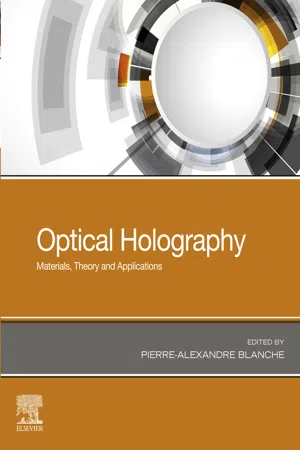
- 222 pages
- English
- ePUB (mobile friendly)
- Available on iOS & Android
About This Book
Optical Holography: Materials, Theory and Applications provides researchers the fundamentals of holography through diffraction optics and an overview of the most relevant materials and applications, ranging from computer holograms to holographic data storage. Dr. Pierre Blanche leads a team of thought leaders in academia and industry in this practical reference for researchers and engineers in the field of holography. This book presents all the information readers need in order to understand how holographic techniques can be applied to a variety of applications, the benefits of those techniques, and the materials that enable these technologies.
Researchers and engineers will gain comprehensive knowledge on how to select the best holographic techniques for their needs.
- Covers current applications of holographic techniques in areas such as 3D television, solar concentration, non-destructive testing and data storage
- Describes holographic recording materials and their most relevant applications
- Provides the fundamentals of holography and diffraction optics
Frequently asked questions
Information
Introduction to Holographic
Abstract
Keywords
A Short History
Table of contents
- Cover image
- Title page
- Table of Contents
- Copyright
- List of Contributors
- Preface
- Chapter 1. Introduction to Holographic Principles
- Chapter 2. Holographic Recording Media and Devices
- Chapter 3. The Gerchberg-Saxton Phase Retrieval Algorithm and Related Variations
- Chapter 4. Holographic Television
- Chapter 5. Digital Holography
- Chapter 6. Holographic Interferometry: From History to Modern Applications
- Chapter 7. Holographic Sensors
- Chapter 8. Holographic Security
- Index